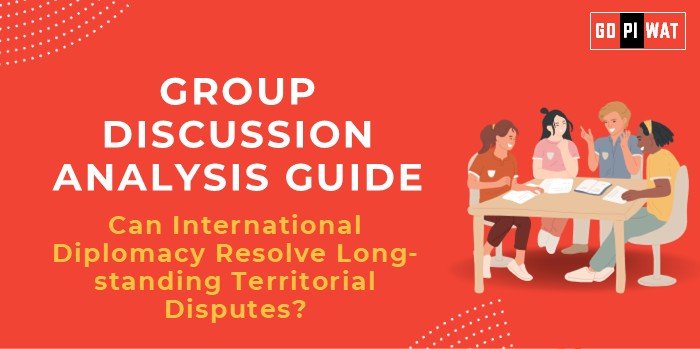📋 Group Discussion Analysis Guide: Can International Diplomacy Resolve Long-standing Territorial Disputes?
🌐 Introduction to Territorial Disputes in Diplomacy
📖 Opening Context
Territorial disputes have shaped global geopolitics, leading to wars, fragile ceasefires, and prolonged instability. Resolutions often test the efficacy of international diplomacy.
📜 Background
From post-WWII agreements to recent efforts in the South China Sea or Indo-Pak borders, diplomacy remains a central tool in conflict resolution. Historical successes like the Camp David Accords show its potential, but failures such as the Syrian Golan Heights dispute underscore limitations.
📊 Quick Facts and Key Statistics
- 🌍 Global Disputes: Over 150 active territorial disputes globally (UNDP, 2024).
- 💰 Economic Impact: The Kashmir conflict has cost India and Pakistan an estimated $50 billion in lost trade.
- 🤝 Mediated Agreements: 85% of border treaties since 1945 involved third-party mediation (World Bank).
- ⚔️ Military Spending: Nations involved in disputes allocate up to 20% more of their GDP to defense than peaceful neighbors.
🤝 Stakeholders and Their Roles
- 🏛️ Governments: Primary negotiators and enforcers of treaties.
- 🌐 International Organizations: UN, ICJ, and regional groups mediate disputes and ensure compliance.
- 🏢 Private Sector: Promotes trade and economic cooperation as conflict resolution tools.
- 📢 Civil Society: Advocates for peace and ensures grassroots perspectives are included in resolutions.
🏆 Achievements and Challenges
✨ Achievements
- 🤝 Egypt-Israel Peace Treaty (1979): Resolved territorial issues with UN-backed diplomacy.
- 🌍 Norway’s Mediation in Sri Lanka: Showed how third-party states could lead peace dialogues.
- ⚖️ Arbitration Success: ICJ successfully resolved 91 cases of maritime disputes since 1990.
⚠️ Challenges
- 🛡️ Sovereignty Sensitivities: States’ unwillingness to compromise often stalls resolutions.
- 🔓 Lack of Enforcement: Agreements like the Minsk Protocol lack enforcement mechanisms.
- ⚖️ Power Imbalances: Unequal negotiations (e.g., Rohingya Crisis) often fail.
🌍 Global Comparisons
- ✅ Positive: EU successfully resolved intra-member territorial claims, strengthening the union.
- ❌ Negative: South China Sea disputes persist despite multiple diplomatic efforts.
📖 Case Studies
- 🇮🇳 Kashmir: Diplomatic deadlock despite several initiatives.
- 🇸🇸 South Sudan: Successful 2005 peace agreement but ongoing issues.
💡 Structured Arguments for Discussion
- 🛠️ Supporting Diplomacy: “Diplomacy resolves disputes by fostering dialogue, as seen in the Camp David Accords.”
- 🛡️ Opposing Diplomacy: “Many territorial conflicts persist due to non-compliance and the politicization of international institutions.”
- ⚖️ Balanced Perspective: “Diplomacy can work with strong frameworks, but challenges like sovereignty claims remain significant obstacles.”
🎯 Effective Discussion Approaches
🔑 Opening Approaches
- 📊 Powerful Statistic: “150 territorial disputes remain unresolved today—can diplomacy end this cycle of conflict?”
- 📖 Historical Angle: “From post-WWII treaties to the South China Sea, diplomacy’s track record is mixed.”
⚙️ Counter-Argument Handling
- 🔄 Example: Highlight the ICJ’s success rate in maritime disputes to counter criticism of inefficiency.
🧠 Strategic Analysis of Strengths and Weaknesses
SWOT Analysis:
- 💪 Strengths: Global frameworks like the UN, historical successes.
- 🛠️ Weaknesses: Enforcement challenges, sovereignty issues.
- 🌟 Opportunities: Rise of multilateral trade agreements promoting peace.
- ⚠️ Threats: Escalation of military conflicts, geopolitical rivalries.
🏫 Connecting with B-School Applications
📚 Real-World Applications
- 🌍 Trade negotiations and global peace projects in operations/finance.
🎓 Sample Questions
- ❓ “What lessons can B-schools learn from failed diplomacy?”
- ❓ “How can businesses influence peaceful resolutions?”
💡 Insights
- 📈 Incorporate global economic strategies and risk management in peace processes.


